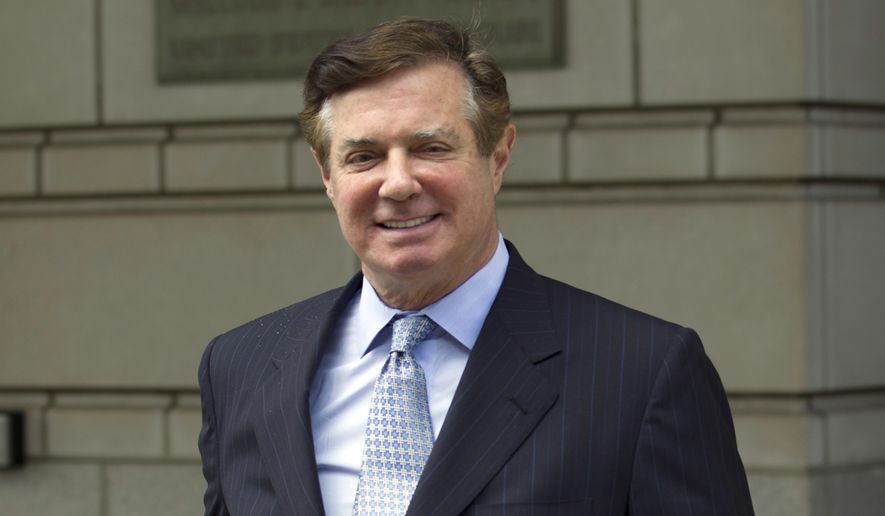ANALYSIS:
Paul Manafort’s passports don’t show he entered London in all the years claimed by Guardian newspaper when it said he met secretly with WikiLeaks Julian Assange.
The Guardian said he met with Mr. Assange in London in 2013, 2015 and 2016.
A review of Manafort’s two passports shows he entered Heathrow Airport since 2008 on two occasions, in 2012 and on another time where the customs stamp year is blurred. It appears to be either 2010 or 2016.
Prosecutors entered two of the three passports into evidence.
Manafort says he has never met Mr. Assange.
The liberal Guardian newspaper on Tuesday claimed that Manafort in the spring of 2016 met with Mr. Assange, the WikiLeaks chief, in the Ecuadorian Embassy in London. The story cited “sources.”
WikiLeaks, which released streams of emails from the Democratic Party and Hillary Clinton’s campaign chairman John Podesta, immediately denounced the story as a hoax and said it planned to raise money to file a libel suit. Manafort, who was convicted of multiple charges including tax evasion and is in jail, also emphatically denied the story and threatened a libel suit.
A Manafort spokesman declined to comment.
His attorney previously explained the multiple passports this way: One was lost, one was used to submit to foreign embassies for visas, and one was used as a backup.
Special counsel Robert Mueller said in an Oct. 31, 2017 filing, after Manafort was indicted on fraud charges, that the political operative and real estate developer maintained three passports and was a flight risk.
Manafort was ultimately convicted by a jury in Alexandria. He pleaded guilty to fraud charges in U.S. District Court in D.C. in September.
The Mueller filing said that Manafort, in the last year, “traveled to Dubai, Cancun, Panama City, Havana, Shanghai, Madrid, Tokyo, and Grand Cayman Island.”
It doesn’t mention London.
Manafort was a frequently flyer with clients in Europe, South America and Asia.
In what is sure to enliven conspiracy theorists, one of his business clients was Ecuador, where he visited in 2017. He traveled with an email account under a fake name. His friends said he covered his identify on emails for security. He traveled under his own passport.
Mr. Assange was granted refuge by Ecuador six years ago. He had faced assault charges in Sweden but now fears extradition to the U.S.
Manafort responded to the Guardian story: “This story is totally false and deliberately libelous. I have never met Julian Assange or anyone connected to him. I have never been contacted by anyone connected to WikiLeaks, either directly or indirectly. I have never reached out to Assange or WikiLeaks on any matter. We are considering all legal options against the Guardian who proceeded with this story even after being notified by my representatives that it was false.”
Said WikiLeaks on Twitter, “Remember this day when the Guardian permitted a serial fabricator to totally destroy the paper’s reputation. @Wikileaks is willing to bet the Guardian a million dollars and its editor’s head that Manafort never met Assange.”
The Guardian story was written by Luke Harding, who promotes the Trump-Russian collusion allegation brought by ex-British spy Christopher Steele. Mr. Harding relied on Mr. Steele’s information for a book.
Paid by the Hillary Clinton campaign and Democratic National Committee, Mr. Steele wrote a series of memos in 2016 based on an array of unnamed Kremlin sources. He brought the dossier to the United States with the aim of destroying the Trump presidency, according to an FBI document.
None of Mr. Steele’s core collusion charges against Trump associates, such as Manafort, has been proven publicly.
For example, Mr. Steele said that Manafort, while briefly Mr. Trump’s campaign chairman, worked with volunteer Carter Page to coordinate Russia’s computer hacking.
But both men say they have never spoken, and there is no public evidence they did what Mr. Steele alleged.
Mr. Steele also accused former Trump lawyer Michael Cohen of secretly visiting Prague in August 2016 to make payoffs to Russian President Vladimir Putin’s aides to cover up the supposed Trump-Russia conspiracy.
After the BuzzFeed news site published the dossier in January 2017, Mr. Cohen showed his passport to selected reporters to prove he didn’t go to Prague.
Fusion GPS, the investigative firm that handled Mr. Steele, said Mr. Cohen’s passport showing wasn’t good enough.
Co-founder Glenn R. Simpson testified to the House Permanent Select Committee on Intelligence that Mr. Cohen should turn over more personal records. He also suggested Mr. Cohen could have traveled to Prague by way of a yacht and Russian plane.
(Correction: This story initially said Manafort didn’t have access to his passports because they were seized by the government. Two passports were seized and then put into evidence at his trial. Also, an updated version of the story corrected Manafort’s charges.)
• Rowan Scarborough can be reached at rscarborough@washingtontimes.com.




Please read our comment policy before commenting.